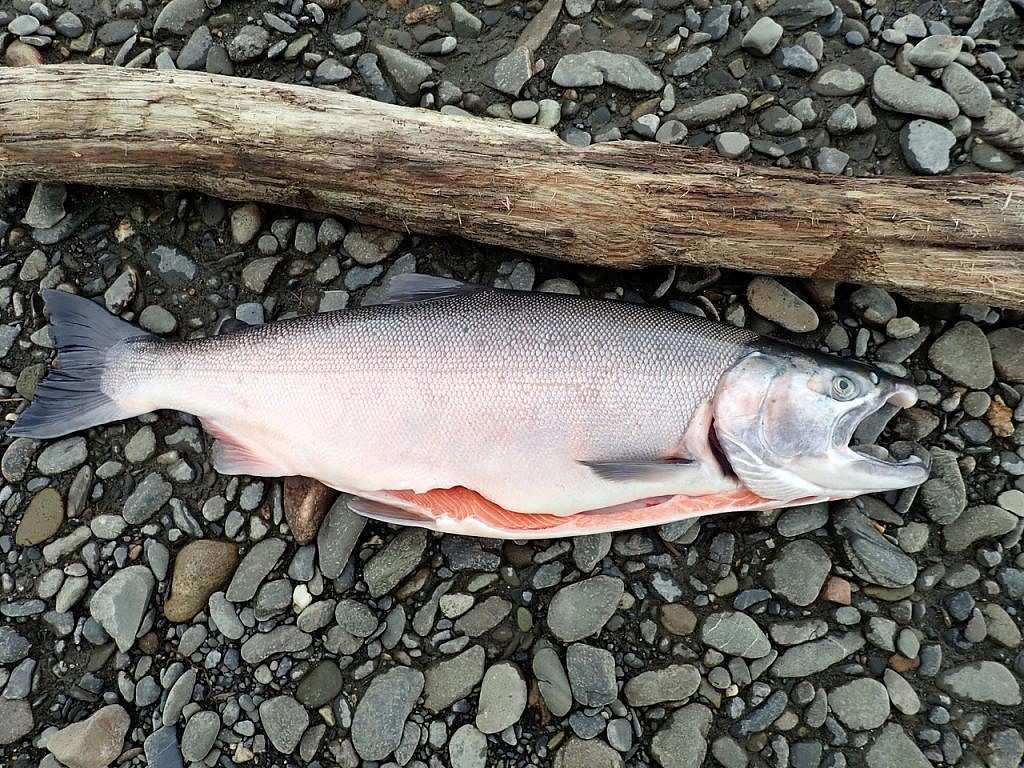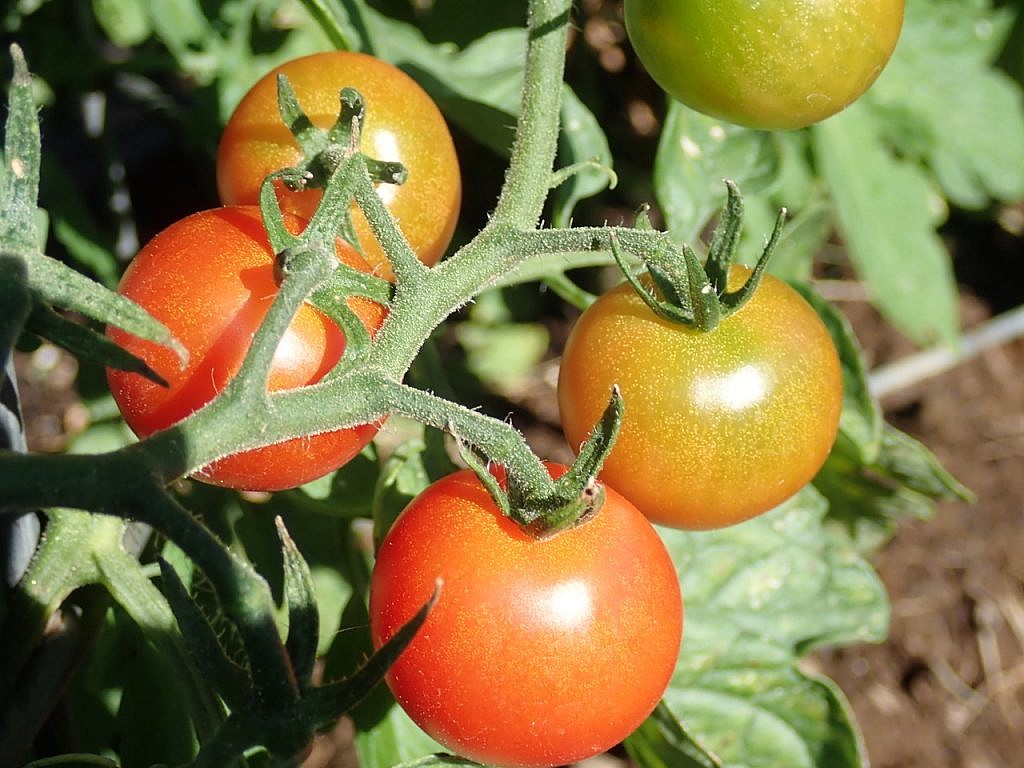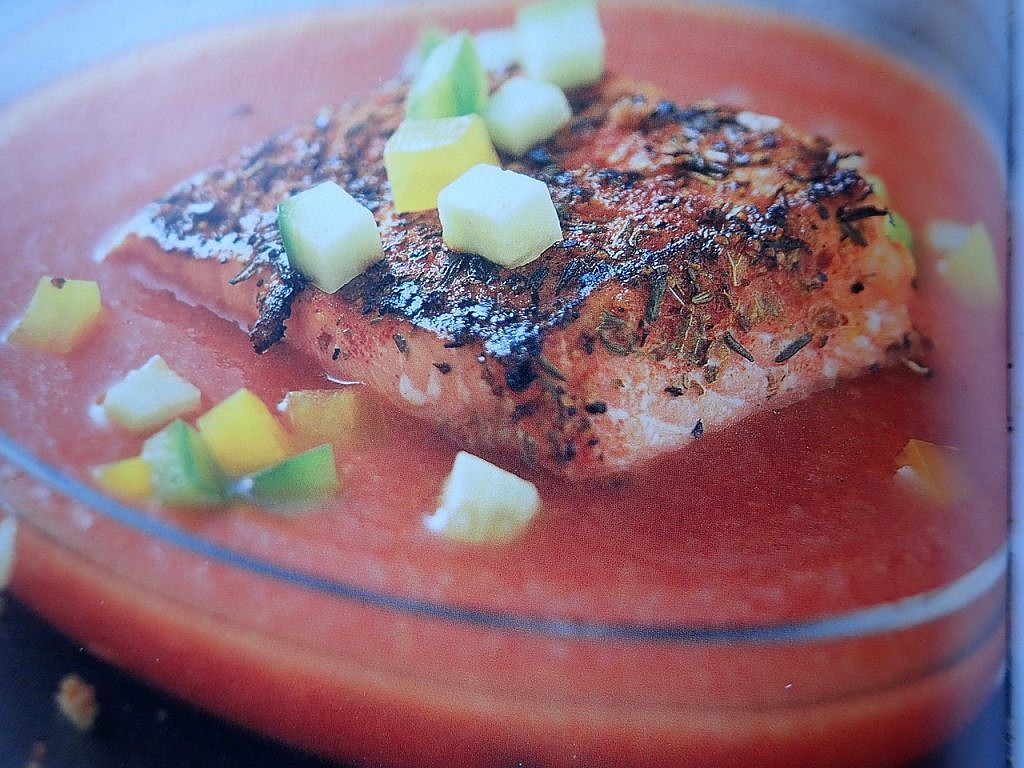
by Scott Sadil
Now’s the hour.
Your tomatoes, I trust, are ripening – with luck, more of them than you know what to do with.
Next step: Get yourself a good late-summer, early-fall fish, a hatchery steelhead or bright, upriver chinook. In a short while, you might just as easily run into a coho or silver salmon, dumped as smolts by the millions into upstream tributaries, a strategy embraced by First Nations hatcheries in an attempt to re-invigorate dwindling runs of all native Columbia Basin salmonids, vanishing, it would seem, right before our eyes.
Then again, what the heck, if all else fails, head to the market and purchase one or two salmon fillets, a pound or two of meat in all. Atlantic salmon might work as well, but there’s a good chance you’re now running into “farmed” or pen-raised fish, which, along with ethical issues, sort of defeats the purpose of this kind of seasonal recipe, a celebration of regional abundance that speaks to the wealth and fecundity of a place you call home.
But don’t get me wrong: I’d be just as happy trying out this recipe with, say, a California halibut, some striped bass, probably any kind of snapper, and certainly mahi mahi – aka, dorado.
In all honesty, however, I’d probably draw the line before I got to walleye.
Just saying.
Meanwhile, back in the kitchen, skin the salmon fillets and, with a pair of needle-nose pliers, remove the pin bones. Then cut the meat into six equal portions, each about two or three inches square. Might as well step outside now and harvest three or four pounds of those fresh garden tomatoes, too.

Finally, before we really jump into this, we need some blackening spice. I’m using a recipe from Diane Morgan’s Salmon cookbook (and quoting from it liberally), but I suspect some readers have their own secrets for this kind of seasoning. What follows here makes plenty for this and many other meals, whether used for fish, other seafood, on burgers, beef, or pork, for either the blackening method described below or as a rub when grilling.
Blackening Spice
2 tablespoons kosher salt
2 tablespoons sugar
1 tablespoon freshly ground pepper
1 tablespoon plus one teaspoon cayenne pepper
2 tablespoons paprika
1 tablespoon dried thyme
1 tablespoon dried oregano
All you need to do with these ingredients is combine them in a small bowl, stir well to blend and, after we finish here, store in a jar in a cool dark place for up to six months.
While we’re looking at ingredients, here is the rest of what we need.
One four-inch-long piece of baguette, crust removed, cut into half-inch dice
2 large cloves garlic
¾ teaspoon ground cumin
2 teaspoons kosher or sea salt
2 teaspoons sugar
3 tablespoons sherry vinegar
3 or 4 pounds ripe tomatoes, cored and cut into eighths
1/3 cup extra-virgin olive oil
Chunks of salmon as described above
2 or 3 tablespoons Blackening Spice (see above)
2 tablespoons vegetable oil
Garnish
½ cucumber, peeled, halved lengthwise, seeded, and cut into ¼-inch dice
½ green bell pepper, seeded, de-ribbed, and cut into ¼-inch dice
½ yellow bell pepper, seeded, de-ribbed, and cut into ¼-inch dice
Okay, here we go, Diane Morgan’s “Bell Pepper and Vine-Ripened Tomato Gazpacho with Blackened Salmon.”
Gazpacho
“Put the bread in a small bowl and cover with water. Soak the bread for one minute and then drain the water. Squeeze the bread dry and set aside.
“In a food processor fitted with metal blade, process the garlic, cumin, salt, and sugar until finely chopped. Add the bread and process until finely chopped, scraping down the sides once. Add the vinegar and pulse to combine. Add half of the tomatoes and process until finely chopped. Add the remaining tomatoes and process until puréed. With the machine running, gradually add the olive oil in a thin, steady stream until the soup is completely puréed, about one minute.
“Set a fine-mesh sieve over a bowl large enough to hold the soup. Working in batches, force the soup through the sieve using the back of a large spoon, pressing firmly on the solids to extract as much liquid as possible. Discard the solids. Taste the soup and add more salt and vinegar, if desired. Cover and refrigerate until cold, at least three hours. (At this point, the soup can be covered and refrigerated for up to two days.)
“One hour before serving, coat both sides of the salmon fillets with some of the blackening spice.
Set aside at room temperature. Twenty minutes before serving, heat a large, heavy skillet, preferably cast iron, over high heat until a drop of water sprinkled in the pan sizzles and evaporates immediately. Turn your exhaust fan on high. Add the vegetable oil, swirl to coat the bottom of the pan, and carefully place the salmon pieces in the pan without crowding. (Blacken the salmon in two batches if necessary.) Cook the salmon undisturbed until it blackens on the first side, two to three minutes. Adjust the heat if the salmon is blackening too quickly. Turn the salmon and cook the other side until blackened and almost opaque throughout, two to three minutes. Transfer the salmon to a plate and set aside at room temperature for ten minutes to cool slightly.
“To serve the gazpacho, ladle a little less than one cup into each of six large, shallow soup or pasta bowls. Carefully place a piece or two of salmon in the center of each bowl. Scatter some of the cucumber and green and yellow pepper over the soup. Serve immediately.”

Ms. Morgan suggests serving this dish with Spanish albariño or Portuguese alvarinho.
Like many men and women who live alone, Gray’s Angling Editor Scott Sadil relies on a few good recipes in an attempt to occasionally impress his friends.
